the history of yeovil's pubs
PUBS HOME PAGE |
PUBS INTRODUCTION |
PUBS BY NAME |
BEERHOUSES |
sun inn (2)
Grope Lane (Wine Street)
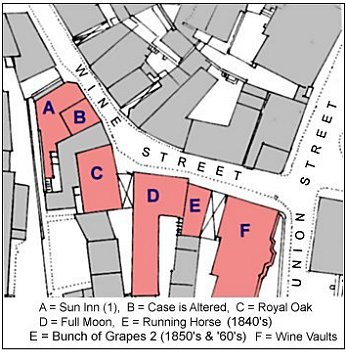 Grope
Lane was
mentioned in the
Woborn Muniments
of 1431 and
comprised the
modern
Wine Street
and the southern
part of
Union Street
which, until the
19th century,
was one
continuous road
joining the
Borough with
Back Street (the
present South
Street).
Grope
Lane was
mentioned in the
Woborn Muniments
of 1431 and
comprised the
modern
Wine Street
and the southern
part of
Union Street
which, until the
19th century,
was one
continuous road
joining the
Borough with
Back Street (the
present South
Street).
The references to the Sun Inn (A on map at left), listed below, do not indicate which part of Grope Lane was graced by the presence of the Sun Inn but by inferring its location relative to other known locations in the census return, it was almost in the Borough and was next door to George Bollen's Case is Altered.
The Sun Inn was an alehouse and certainly was extant in 1695.
The Western Flying Post in April 1790 reported on two suspected arson cases in outhouses behind the Greyhound Inn in the Borough. There was, however, some confusion at the time concerning which public house was burnt as the following was recorded at the court "Alexander Pearce, born at Sherborne, in the County of Dorset, aged 19, was executed at Ilchester, 20 August 1790, for setting fire to the Sun Public House at Yeovil in this County. Denied the fact to his last moment, though unquestionably guilty." (Thomas G Rees, Ordinary to Ilchester Gaol, 1789-1821). The amount of damage to the pub is not known.
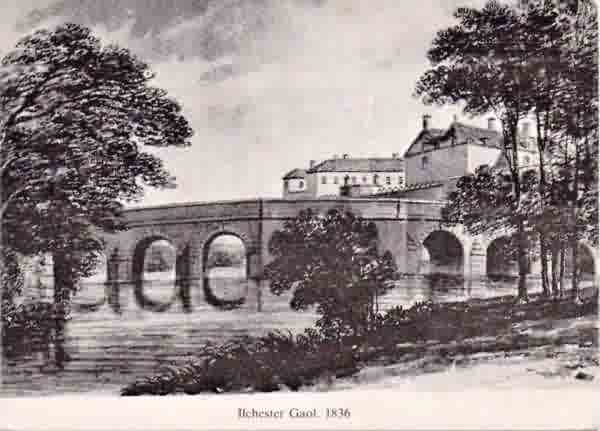
From my
collection
A contemporary sketch of Ilchester Gaol.
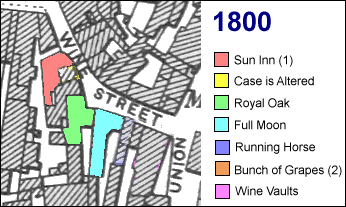 The
animation at
left shows the
development of
the Grope Lane /
Wine Street
premises from
1800 through
1880.
The
animation at
left shows the
development of
the Grope Lane /
Wine Street
premises from
1800 through
1880.
In 1729 the
landlord, a Mr Shearstone, was
recorded in the
Window Tax lists
as liable for
six shillings
tax for the year
-
"Shearstone for
ye Sunne" -
indicating that
it was a
substantial
property with
between ten and
twenty windows.
![]()
I have an indenture in my collection, dated 3 January 1756, for the sale of a property in Grope Lane. From later leases it is known that the property in question, although not named in this document, was the Sun Inn.
Another vellum indenture in my collection being a "lease for a year of a messuage or tenement burgage and Inn called The Sun situate in the parish of Yeovil in the County of Somerset dated 23 December 1840, Messrs Thomas Lemon, Mason of Stalbridge, Dorset, and Samuel Dean blacksmith of Yeovil and occupant of property to Mr William Bide, glove manufacturer of Yeovil." On this lease the first named occupant of The Sun was Lionel Farley, then Sarah Leverage, then Mary Nossiter, then Henry Lillington, then Edmund Batten, then John Batten Snr, then Samuel Dean. Of these, certainly William Bide, Edmund and John Batten were the owners of the property rather than landlords.

From a document
in my
collection
Edmund Batten's signature on a deed dated 1793, for the Sun Inn in Grope Lane. At this time Edmund Batten appeared in his role as solicitor.

From a document
in my
collection
John Batten the Elder's signature on a deed dated 1807 for the Sun Inn. At this time John Batten appeared as a solicitor and at this time Edmund Batten purchased the Sun Inn.
The 1793 Universal British Directory listed Mary Nossiter as a victualler of the Sun Inn in Grope Lane, today's Wine Street. Although Mary was listed as the licensee of the Sun Inn is almost certain, as was normal practice, that she would run the pub during the day while her husband John Nossiter, a carpenter, worked and then he would take over in the evenings. In 1815 there was an interesting bankruptcy reported for John Nossiter whose creditors included maltsters from as far away as Bristol and the Yeovil brandy merchants, Bullock, Watts & Cayme the Younger. For further information - see here.
Very little is known about Thomas Colborne other than he was born about 1786 outside Somerset and he appears in Pigot's Directory of 1822 as the licensee of the Sun. In the 1841 census he is listed as a 55-year old labourer living with his wife (?), Mary, aged 70.
Samuel Dean, born about 1791, is first mentioned as licensee of the Sun Inn in Pigot's Directory of 1824 and makes several more listings in various trade directories up until 1840. In a lease (see note below) dated 23 December 1840 he is noted as a 'Blacksmith of Yeovil'. The owner of the inn at this time was William Bide. In the 1841 census Samuel is listed as living in Middle Street with his wife, Sarah, two daughters, Sarah and Frances, and a son, James. Both Samuel and James described their occupations as smith. Samuel died in 1851, aged 60.
Samuel Russell was born around 1790 and is listed in the 1841 census as a beer seller living with his wife, Harriett, and their three daughters. Samuel died in 1850 and in the 1851 census Harriett and one of their daughters was living in Bond Street.
INDENTURES FOR THE SALE OF THE SUN INN
-
1756 - Indenture, Sale of the Sun Inn
John Priddle, Henry Priddle and John Hopkins to William Knott. -
1769 - Grope Lane Indenture (the Sun Inn)
Property transfer from John Priddle of Tintinhull to Lionel Farley -
1793 - Indenture, Sale of the Sun Inn
Thomas Tompkins, Grace Farley and Lionel Farley Jnr to Sarah Leveridge -
1807 - Indenture, Sale of the Sun Inn
Mary Nossiter to Edmund Batten and Henry Lillington -
1810 - Indenture, Sale of the Sun Inn
Mary Nossiter to Edmund Batten, after Henry Lillington didn't pay [?] -
1840 - Sale of the Sun Inn
By Thomas Lemon of Stalbridge and Samuel Dean of Yeovil to William Bide
Note: In the indentures referred to above, it is possible to establish the following list of owners and/or occupiers of the Sun Inn.
-
John & Henry Priddle of Tintinhull (owners) until sale of 1765 to Lionel Farley Snr
-
William Knott, licensee from 1756
-
Lionel Farley Snr (1731-1806) - owner of property, 1765-
-
Grace Farley nee Glyde (1733-1812), widow of Lionel Farley Snr - owner of property
-
Lionel Farley Jnr, son of Lionel Farley Snr - owner of property before Sarah Leverage
-
Sarah Leverage - former owner and occupant of property before Mary Nossiter
-
Mary Nossiter (listed below in 1793) - former owner of property before Henry Lillington
-
Henry Lillington - former occupant of property after Mary Nossiter
-
Edmund Batten (died 1836) - former owner of property before John Batten
-
John Batten - former owner of property before Samuel Dean
Gallery
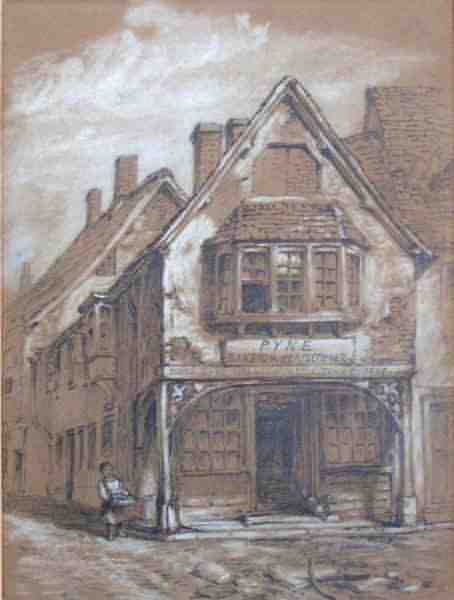
From my
collection
An original pastel and pencil sketch on paper (255mm x 190mm) of Charles Pyne's establishment 'Under Bow', showing part of the Wine Street elevation at left. The taller building next down Wine Street would have been the Sun Inn.
The sketch is by artist Walter Francis Tiffin (1819-1890) of Salisbury, Wiltshire - although at the time of this sketch he was in Sherborne. An attached label reads "Sherborne, W Tiffin, 1865" and a second label, in pencil, reads 'By W F Tiffin'.
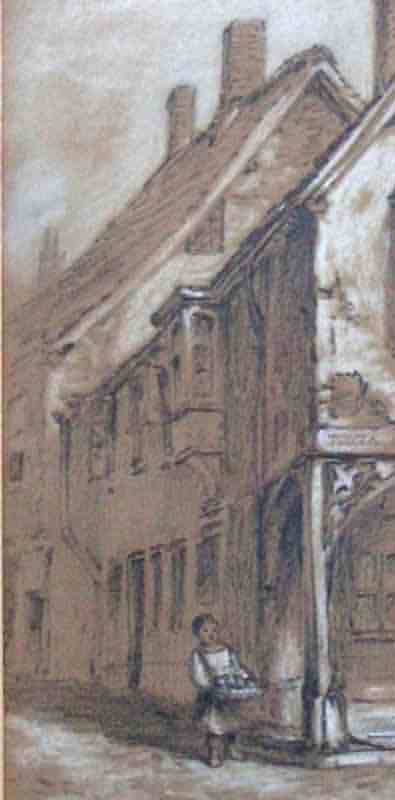
From my
collection
An enlargement of the previous image, looking down Wine Street from the Borough. The taller building to the rear is the only known image of the Sun Inn.
The building known as Under Bow was destroyed by fire in 1861 and finally demolished within the following two years. Its removal allowed for the width of Wine Street to almost double to today's width.
licensees
1695 – Licensee
not listed but
listed as The
Sun (Notes of LC
Hayward)
1729 – Shearstone for
ye Sunn (Window
Tax)
1756 – William
Knott - owner
(see 1756
Indenture)
1760 – Licensee
not listed (Poor
Rate Book)
listed as the
Sun
1769 – Lionel
Farley - owner
(see 1769
Indenture)
1790 – Licensee
not listed, but
the Sun Inn was
damaged through
arson (see
above).
1793 – Sarah
Leveridge –
owner (see 1793
Indenture)
1793 – Mary
Nossiter –
Victualler (1793
Universal
British
Directory)
listed as Sun
1807 – Mary
Nossiter –
Victualler (see
1807 Indenture)
1810 – Mary
Nossiter –
Victualler (see
1810 Indenture)
1822 – Thomas
Colborne
(Pigot’s 1822
Directory)
listed as the
Sun
1824 – Samuel
Dean (Pigot's
1824 Directory)
1827 – Samuel
Dean (1827
Jurors List)
1830 – Samuel
Dean (Pigot’s
1830 Directory)
listed as the
Sun
1835 – Licensee
not named
(Robson's 1835
Somerset
Directory)
listed as Sun,
Wine Street
1839 – Samuel
Dean (Robson’s
1839 Directory)
listed as the
Sun
1840 – Samuel
Dean (1840
Somerset Gazette
Directory)
1840 – Samuel
Dean, occupier -
William Bide,
owner (Lease
dated 23 Dec
1840) called the
Sun
1841 – Samuel
Russell – Beer
Seller (1841
census) pub not
named
1842 – Samuel
Russell –
Retailer of Beer
(Pigot’s 1842-4
Directory)
premises not
named
1845 – R Tucker
(Notes of LC
Hayward)
documentation
|
1760 |
Occupant of the Sun - 1d. (Poor Rate Book) |
|
1790 |
"Alexander Pearce, born at Sherborne, in the County of Dorset, aged 19, was executed at Ilchester, 20 August 1790, for setting fire to the Sun Public House at Yeovil in this County. Denied the fact to his last moment, though unquestionably guilty." (Thomas G Rees, Ordinary to Ilchester Gaol, 1789-1821) |